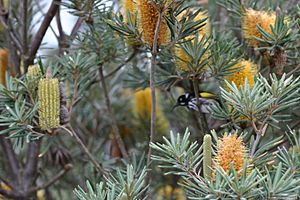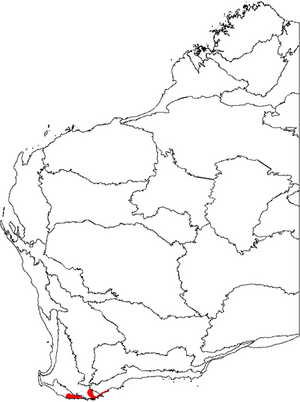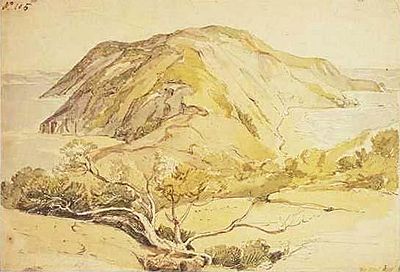Granite banksia facts for kids
Quick facts for kids Granite banksia |
|
|---|---|
 |
|
| Conservation status | |
| Scientific classification | |
| Kingdom: | |
| (unranked): | |
| (unranked): | |
| Order: | |
| Family: | |
| Genus: | |
| Species: |
B. verticillata
|
| Binomial name | |
| Banksia verticillata |
|
 |
|
| Distribution of B. verticillata in Western Australia. | |
The Banksia verticillata, also known as granite banksia or Albany banksia, is a type of shrub or small tree from the Banksia family. It grows naturally in the southwest part of Western Australia. This plant can grow up to 3 meters (10 feet) tall, but in protected spots, it might reach 5 meters (16 feet). In very windy areas, it stays much smaller.
The granite banksia has bright green, oval-shaped leaves and large, shiny golden-yellow flower spikes. These flowers appear in summer and autumn. The New Holland honeyeater is the main animal that helps pollinate this plant, but other honeyeaters and bees also visit the flowers.
This plant is considered a vulnerable species. It grows in two separate areas on granite rocks along the south coast of Western Australia. The biggest group is near Albany, and a smaller one is near Walpole. It is threatened by diseases like dieback and aerial canker. When there's a bushfire, the granite banksia plants usually die. However, new plants grow from their seeds afterward. It takes more than ten years for new plants to produce seeds, so fires need to be spaced out by more than twenty years for the plant to survive.
Contents
Description
The Banksia verticillata is a bushy shrub with many branches. It usually grows up to 3 meters (10 feet) tall. In places that are sheltered from strong winds, it can grow taller, up to 5 meters (16 feet). However, in very windy spots, it might be much shorter or even grow flat along the ground. Sometimes, it can grow as a single-trunked tree.
Its bark is rough and grey with small cracks. Young stems and branches are slightly hairy, but they become smooth as they get older. The leaves are tough and bright green. They grow in a circle around the stem, or sometimes in an alternating pattern. Each leaf is 3–9 cm (1.4–3.8 inches) long and 0.7–1.2 cm (0.3–0.5 inches) wide. They are oval-shaped with smooth edges that curl slightly backward. When they are young, the leaves are hairy, but they become smooth as they mature. The undersides of the leaves stay covered with white hair.
The plant's bright golden-yellow flower spikes appear from January to April (summer and autumn). These spikes are 8–20 cm (3–8 inches) tall and 6.5 cm (2.6 inches) wide. The smooth parts of the flowers that collect pollen are 3–3.5 cm long and have a hook at the end. The individual flowers on the spike open from the bottom upwards. It takes about 9.5 days for all the flowers on a spike to open. After the flowers fade, the spikes turn grey, and the old flowers stay on for a while before falling off.
Up to 100 small, woody seed pods, called follicles, can form on the old flower spikes. These pods are 1.1–1.5 cm wide and 3–4 mm thick. They stick out 2–3 mm from the spike. The pods open after several years to release the seeds. Most of the pods grow in the middle part of the flower spike. Scientists are not sure why this happens.
Discovery and Naming
The first time a Banksia verticillata plant was collected by a botanist was in 1791. A Scottish surgeon and naturalist named Archibald Menzies found it during an expedition to King George Sound. Because of this, the plant was brought to England to be grown, but it wasn't officially named then.
The next time it was collected was in December 1801, during a visit by the ship HMS Investigator to King George Sound. The specimen was credited to Robert Brown, a famous botanist.
Robert Brown officially described and named the species in 1810 in his book On the Proteaceae of Jussieu. He didn't explain why he chose the name, but it's believed that verticillata comes from a Latin word meaning "whorled." This refers to how the leaves grow in circles around the stem.
Scientists don't recognize any different types or varieties of Banksia verticillata. It has only one other scientific name, Sirmuellera verticillata, which was an attempt to change the name of the Banksia group.
How Scientists Classify Plants
Scientists group plants together based on their shared features. This helps them understand how different plants are related. For a long time, there was some confusion between Banksia verticillata and another plant called B. littoralis (swamp banksia). This was because B. littoralis used to include a plant that had whorled leaves, just like B. verticillata. The confusion mostly ended when scientists realized that the plant with whorled leaves was actually a separate species, now called Banksia seminuda.
Today, Banksia verticillata is placed in the Banksia genus, which is a large group of plants. It is considered closely related to a few other banksias, such as B. littoralis, Banksia seminuda, B. brownii, and B. occidentalis.
Distribution and Habitat
Banksia verticillata is found in a few separate areas in Western Australia. One group of plants is found around Walpole, and another group is found around Albany and further east to Cheynes Beach. Almost all of these plants grow within 2 kilometers (1.5 miles) of the coast. Only one group is found a bit further inland, less than 10 kilometers (6 miles) from the sea.
These plants grow on exposed coastal granite rocks. They often grow in cracks within large boulders or in shallow, rocky soils. Banksia verticillata is the only Banksia species that grows only in granite soil. It often grows alongside other plants like Taxandria marginata, Western Australian peppermint, and different types of Hakea in scrubland and heathland areas.
Ecology
Pollination
The New Holland honeyeater is a very important visitor and pollinator for Banksia verticillata. These birds can fly up to 15 meters (50 feet) between flower spikes while feeding. They prefer to visit flower spikes where some flowers have already opened. Other honeyeater species, like the white-cheeked honeyeater and western spinebill, also visit these plants but not as often. The brown honeyeater has also been seen visiting. Small mammals like bush rats and house mice have been recorded, but they are not major pollinators. Honey bees visit the flower spikes, but they don't help much with pollination.
Threats and Survival
Banksia verticillata is seriously threatened by at least three types of tiny living things (microorganisms). Many groups of these plants have shrunk or disappeared because of a disease called dieback (caused by Phytophthora cinnamomi). This has happened in places like Two Peoples Bay Nature Reserve and Gull Rock National Park. Another fungus, Armillaria luteobubalina, has killed plants in Torndirrup National Park. A disease called aerial canker (caused by Zythiostroma) has also destroyed many plants in Waychinicup National Park near Albany.
Life Cycle and Fire
When a bushfire happens, Banksia verticillata plants usually die. However, new plants grow from their seeds afterward. A study in 1994 found that after a small fire, plants that had been burned were ten times more likely to have seedlings grow under them compared to unburnt plants. Burnt flower spikes also released twice as many seeds as unburnt ones.
Even without fires, some seedlings can grow between fires. Observations show that many plants start producing their first seeds when they are 13 to 17 years old. Because of this, experts suggest that there should be at least 20 years between fires. This allows enough seeds to build up in the plant's canopy (the top part of the plant). If fires happen too often, plants are burned before they are old enough to make seeds, or before they have made enough seeds for new plants to grow. This can cause the number of plants to drop or even make them disappear from an area. If there's too much time between fires, plants might die naturally without releasing their seeds, which means the seeds are wasted.
Conservation
The Banksia verticillata is officially listed as vulnerable under Australia's federal Environment Protection and Biodiversity Conservation Act 1999. It is also listed as Rare in Western Australia. A count in 1995 estimated that there were about 4500 plants in total. Besides diseases like dieback and aerial canker, frequent bushfires and people illegally picking the plants are also threats.
To protect these plants, scientists are:
- Watching the existing groups of plants.
- Collecting more information on how the plants respond best to fire.
- Limiting access to the areas where the plants grow.
Seeds have been collected from many groups of plants. However, these seeds don't sprout as well after ten years of storage compared to seeds from other banksias. Moving plants to new areas (called translocation) is being considered for the future. Spraying plants with a chemical called phosphite is also an option, especially near Walpole. Phosphite has been used successfully on another banksia species. It helps both healthy and infected plants resist disease and also acts as a direct fungicide (a chemical that kills fungi). Spraying phosphite from the air helps plants survive and slows the spread of infection. However, it needs to be done carefully because studies show that spraying phosphite on leaves can harm root and shoot growth.
Cultivation
Banksia verticillata is not often grown in gardens. For it to grow well, it needs a sunny spot and soil that drains water easily. It is a good plant for coastal areas and for preventing soil erosion. However, like most banksias from Western Australia, it is very sensitive to dieback disease. It dies quickly in humid conditions or if the soil doesn't drain well. It has been successfully grafted onto another banksia species, Banksia integrifolia. The seeds do not need any special treatment and usually sprout within 19 to 49 days.
- Banksia verticillata — Granite Banksia, Albany Banksia, River Banksia, Species Profile and Threats Database, Department of the Environment and Heritage, Australia.
See also
 In Spanish: Banksia verticillata para niños
In Spanish: Banksia verticillata para niños



